

| Home | For sale | Site map | Contact information | Guest book |
 MP
38. u. 40 transport box MP
38. u. 40 transport box
 |
|---|
|
Welcome to a detailed walk through the details and specifications of the MP 38. u. 40 transport box! One of the rarest accessories for the MP 38. u 40 was the wooden transport box. Only a handful of examples are known to exist today, and so far I have been unable to find any contemporary documentation that they in fact existed. But let it be firmly stated from the start; they did exist, and were manufactured by at least two different manufacturers from 1940 to 1944. The exact purpose of the box must have been transport and/or storage. Several theories have been put forward, but no conclusion has yet been reached. I will summarize the "pro et cons" at the end of this article. Addendum! All good things comes to those who wait. The specific purpose of the box has now been identified and will be revealed further down. The overall view and construction "It's just a wooden box for crying out load! How interesting can it be?" ....my wife said. Well, this one is above average in most ways. It is constructed as a suitcase, made as sturdy as possible, while at the same time keeping dimensions and weight as low as possible. The walls are solid wood with dovetailed corners. The bottom is made from one piece of plywood and has been attached with screws. The lid is also made of plywood and is attached to a piano hinge at the rear. It sits recessed and protected by the side walls.  The carrying handle at the front is constructed with a spring steel center covered in faux leather. When grabbed it will slide slightly out of the attachments and return in again when released. This patent and type of carrying handle can be found frequently on Luftwaffe onboard equipment boxes. The box locks are of the standard German WW2 type. 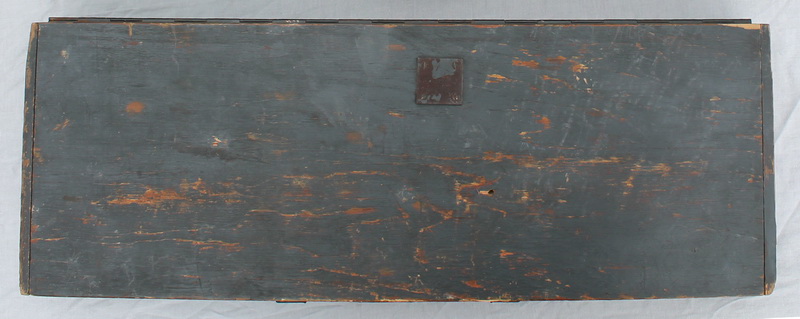 The lid has a small metal plate fastened with four screws as can be seen above. This serves as a blind-cover for the charging handle of the MP38. u. 40. 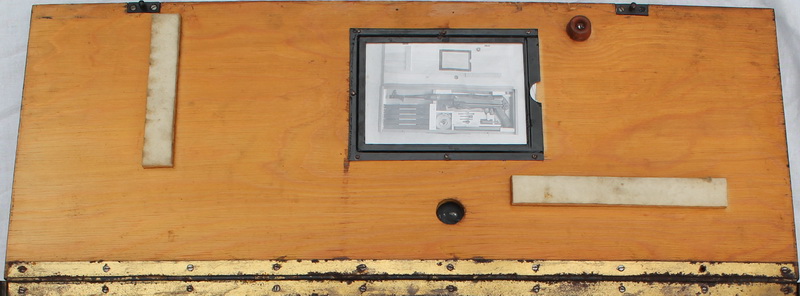 The inside of the lid holds a metal frame with a celluloid inset covering a picture of the contents, functioning as a "list of contents". Below this the hole for the charging handle can be observed. A thin strip of birch wood covered with white wool can be seen in two places. The one to the left will hold the magazines in position. The one to the right lies against the bakelite body of the MP38. u. 40 holding it firmly in place. The last item is a commercial rubber button. It holds the single magazine firmly in place. 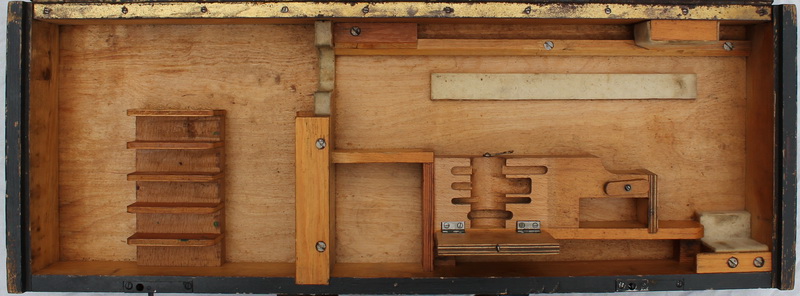 The complicated interior! It is constructed from three different types of wood. Some parts are screwed in and some parts are only glued. Birchwood is used on critical parts where strength is important, like the piece that holds the spare parts with thin sidewalls. Plywood is used on large surfaced areas that needs to be thin but strong, like the dividing walls for the magazines and the lid over the spare parts, although the lid is slightly thicker. In positions holding the weapon a padding of white wool has been added to avoid marring its finish, acting as a shock absorber and ensuring a tight fit when the lid is closed. A small rotating lock made of birch wood can be swiveled to hold the magazine loader and trigger guard of the weapon in place.  The spare parts compartment was sealed off with a hinged lid with an eyelet at the end, held down by a swiveling hook. 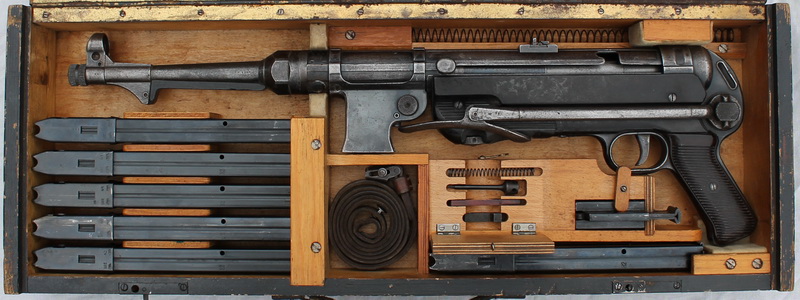 All filled up! Note that the bolt must be in the forward position in order to close to lid. The bolt handle protrudes upwards into the hole in the lid which is sealed with the metal plate on the outside. The markings I have only been able to study two original boxes, one very early and one very late. The early box is in fact so early that it was made solely for the MP38, before the MP 40 was even manufactured. The box has a faint black stencil to the lid to describe the contents. 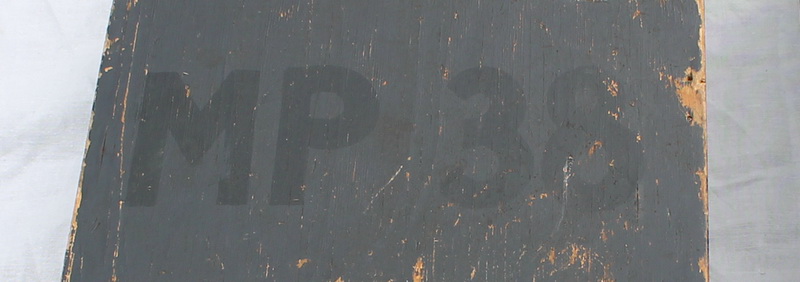 The contents picture was still intact in this box, and shows a MP38. It is not possible to tell if the "MP 38" marking was added by the manufacturer or by the unit, but it seems likely that it was done by the manufacturer (carpenter). The late war box has no such marking. 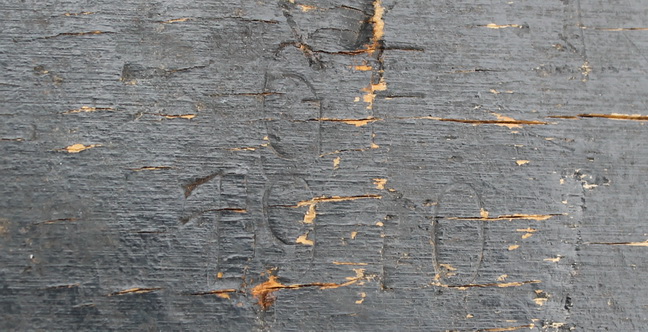 The early production box is maker marked on the centre of the lid with the initials "G.F." and 1940. 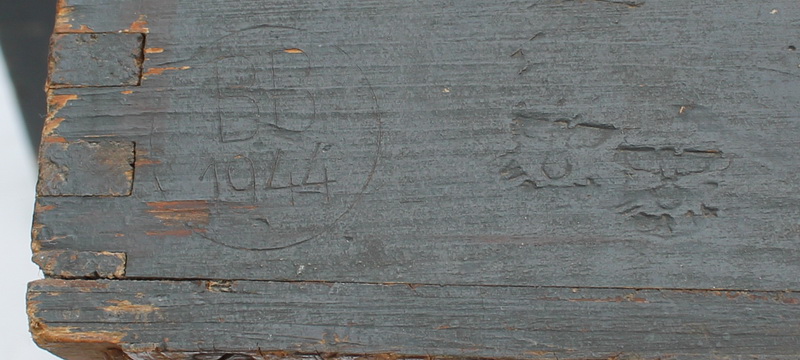 The late production box is maker marked "B.B." 1944 within a circle, and is also proofed with two WaA stamps (army type). Note the simpler (straight) type of dovetailing on this late-war production box. The contents list 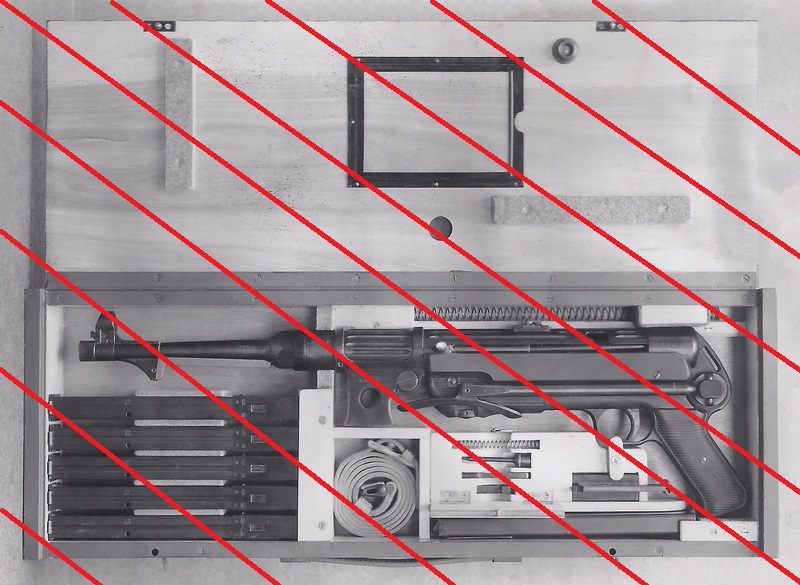 The prototype of the box was used as a model in the picture used as a contents list. Note that the frame for the picture has been mounted, but there is of course no picture in it! Another interesting thing to observe is the sling, which appears to be a K98k sling with a Haltestück. The only visible design changes are in the lid. It is made of solid wood, and the strips of birch wood trimmed with wool appear to have been screwed on. The solid wood lid wouldn't be a very good solution, as it would be bound to twist and warp. Another detail is the painted piano hinge. None of the surviving examples has this feature. The complete contents list with article names would have been:
Contents of the spares box (as listed above)
It is hard to make any sense out of the contents of the box. The normal number of magazines issued with the gun was 7 (1 in the gun and 6 in pouches), but the box has only got room for 6. Most of the spare parts issued with the box would hardly break during normal wear, and if they did they would require some really specialized tools to be changed. History Nothing is known for certain about the use of these boxes during the war. I haven't managed to find any references or any pictures of them. The Gerätliste (“List of devices”) from 1.7.1943 lists the transport box for the P.08 and the transport box for the Sniper K98k. But the transport box for the MP38. u. 40 is nowhere to be found. Two boxes have been recorded as "survivors" within the postwar Norwegian army, used by an armorer. The 1944 dated box pictured at the end of this page was bought from Austria. Another box was sold through Simpson Ltd some years ago, and was reported by the vendor as coming from a police station, also in Austria. 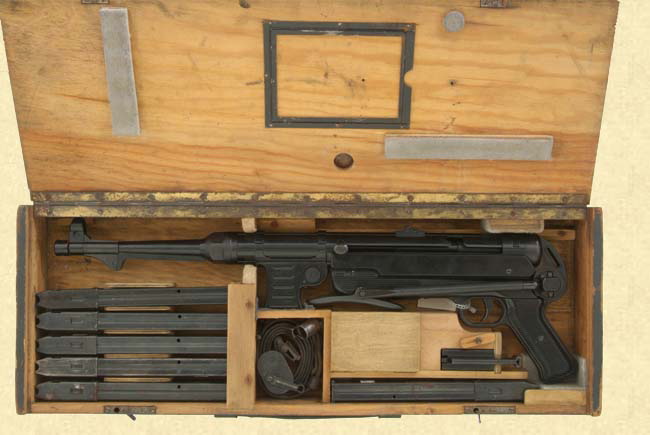 The "Simpson Ltd box". It was displayed on their homepage with a toy gun inside. In addition there is also a MP40 winter trigger and a Portuguese export K98k sight hood/muzzle cover added that do not belong there. It differs from the two other boxes in two details. The single magazine is held by a wool covered disc instead of the rubber button. In addition the single magazine rest on wool pads instead of directly on wooden raisers. Yet another box is pictured in the book "Die Wehrmacht" vol. 1 from 2000, published by Ryton books. The picture has no credits, but it appears to be from a museum collection. Postwar The MP38. u. 40 box is copied extensively. Some to deceit, but most as practical storage and transport boxes for proud MP40 owners. Making the perfect copy is hard though. The sleek design and use of different components hasn't been copied convincingly yet.  The above box is one of many that have been offered for sale on Ebay over the years. Compare it with the known originals above and see if you can spot the differences.... 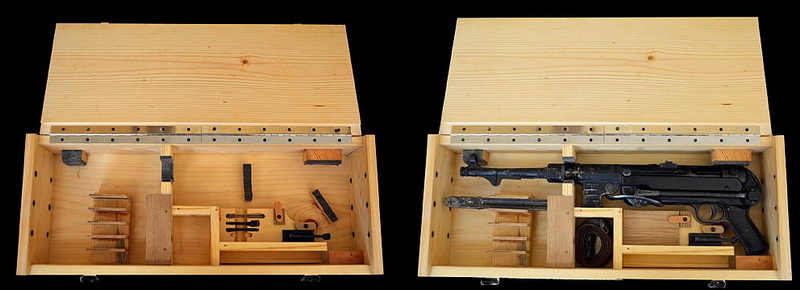 This is one of many versions offered today. Far from a good copy, but a practical storage box for a happy MP owner. 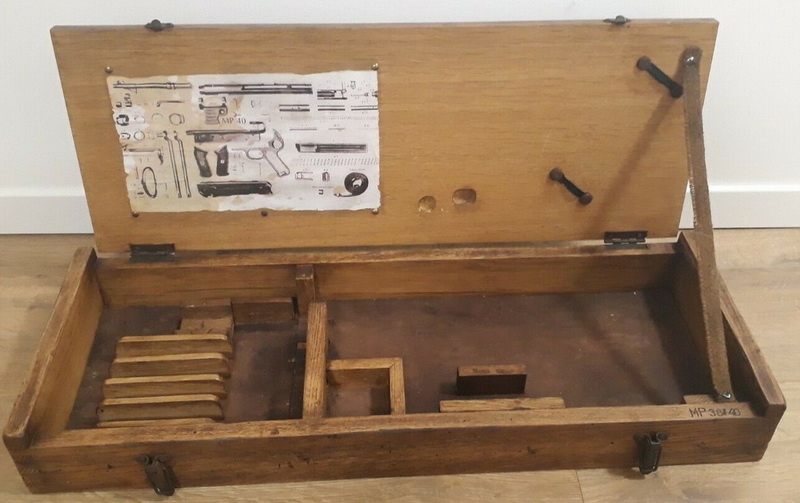 How bad can it get? Recently passed off on Ebay as the real deal. Note the stamp in the lower right corner. The "pro et cons" and total lack of conclusion Why it was constructed and what it was used for (apart from the obvious) remains a mystery. Let us sum up some of the defining facts.
A notice in the Heeres-Verordnungsblatt dated 22. December 1939 bear witness against the "Transport box from the factory" theory. 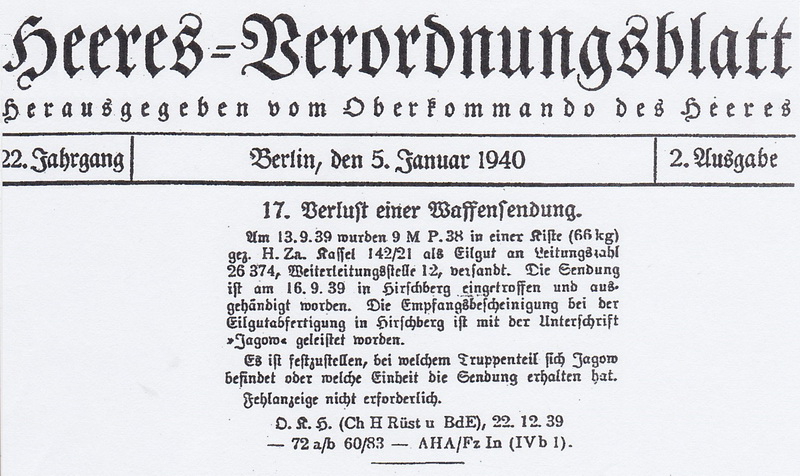 A shipment of 9 MP38 has gone missing, and information about it's whereabouts is wanted. The information of interest is the fact that the weapons were shipped in one box, weighing 66 kg. Since the box was sent as early as 13.9.1939 it is most likely a delivery from another depot or the factory of brand new weapons. Addendum, big time!! 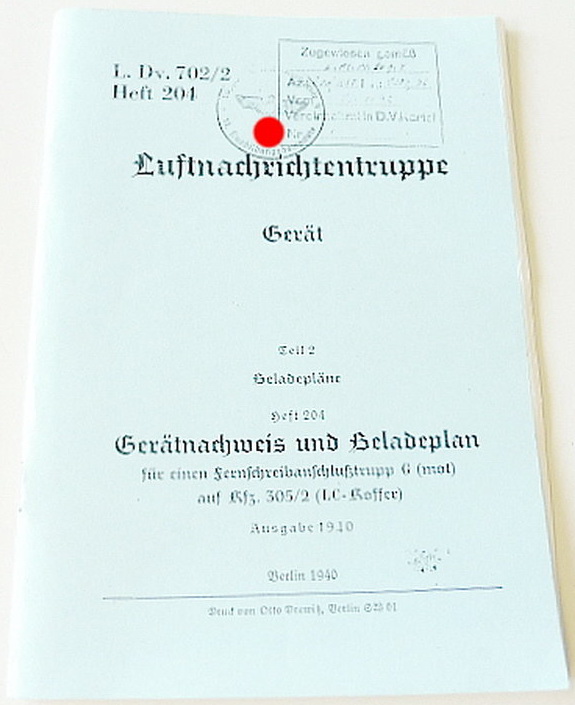 (Picture courtesy of KPEMIG.de) A copy of this manual was sold by the militaria dealer KPEMIG in Germany. The manual is titled
This manual show the MP38 box installed in a vehicle. (So the "vehicle use" theory above was in fact correct). 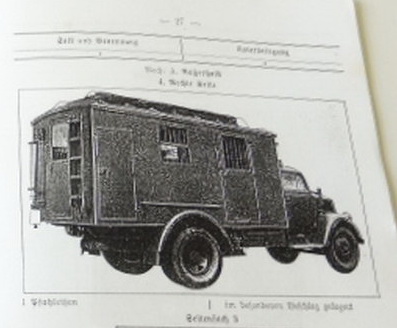 (Picture courtesy of KPEMIG.de) The manual is a "table of contents" for this specific vehicle (Opel Blitz truck with a superstructure), configured as a telex connection point for the Luftwaffe. It is, for the moment, not known if the box was part of any other version of radio-car, and if it was used solely by the Luftwaffe. 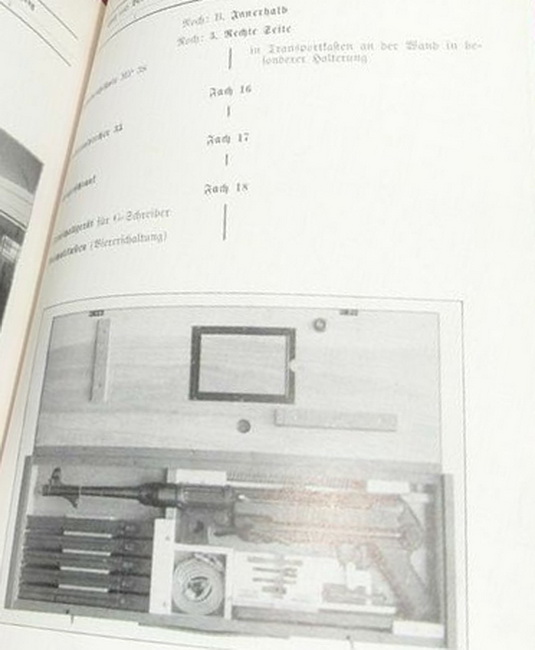 (Picture courtesy of KPEMIG.de) The text translates to Inside. Right side. Maschinenpistole MP38 | In a transport box on the wall, in a special bracket. It is followed by the very same picture (above) that was used as the "contents list" for the box itself. 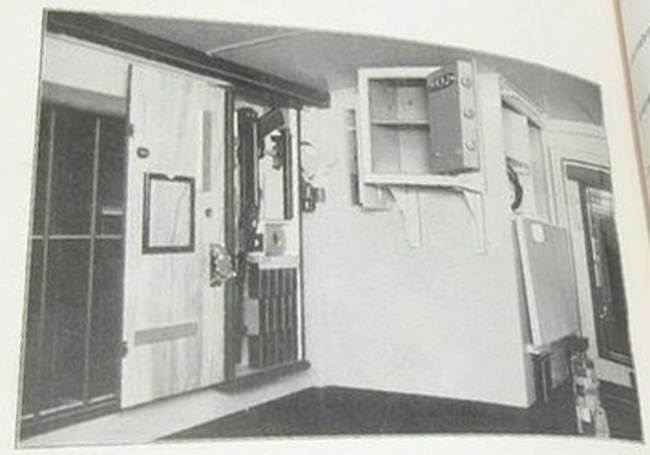 (Picture courtesy of KPEMIG.de) This interior picture (facing towards the rear, waist up) from the superstructure shows the box with the lid open, mounted in the special bracket on the upper right side of the superstructure. The lid can still be opened when the box is mounted in the special bracket. This explains the need for the rotating lock that prevents the MP from falling out and holds and magazine loader in position, as well as the strips of wood that keeps the magazines from falling out when the lid is opened in the upright position (I should have seen that detail !). The box with it's contents was part of the vehicle's accessories, which is the reason why the transport box was not listed in the "Gerät-liste". 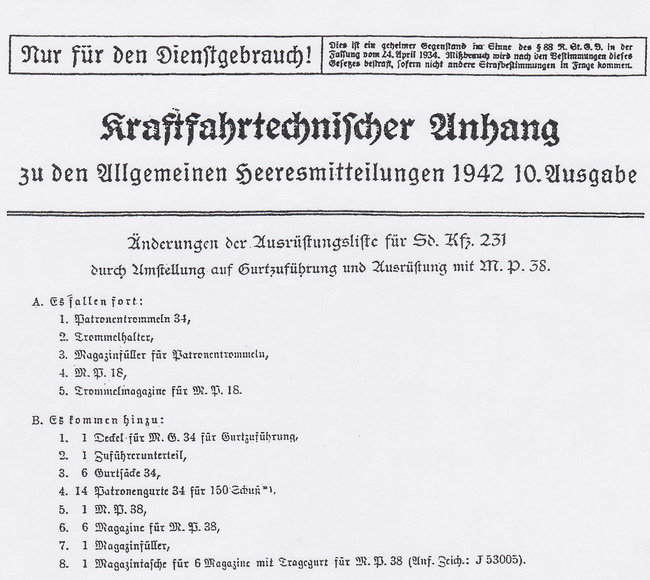  The MP38 was often listed as "onboard armament", used with many different armored vehicle types. The standard equipment appears to be a MP38 (with sling and magazine), 6 magazines, one magazine filler and a six-cell magazine carrying pouch with a carrying sling. The MP38 in the wood box has only got 5 extra magazines, and no pouch to carry them. 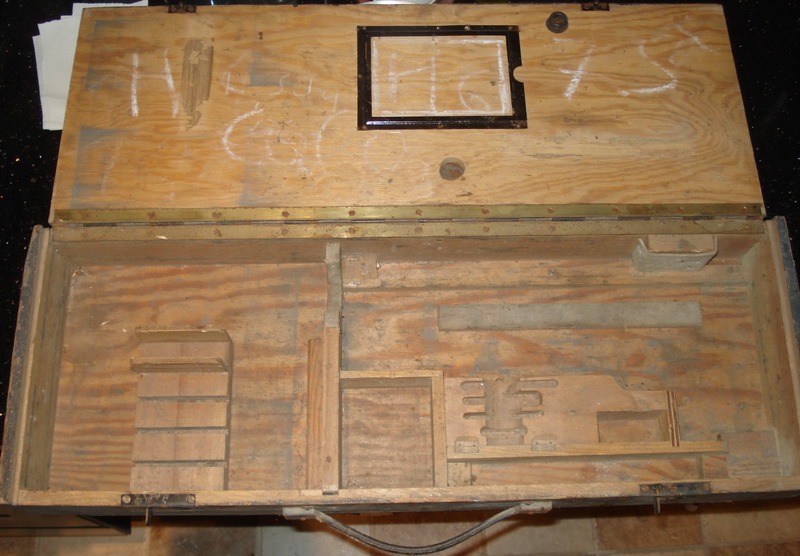 The box from Austria, dated 1944, in "as found" condition. 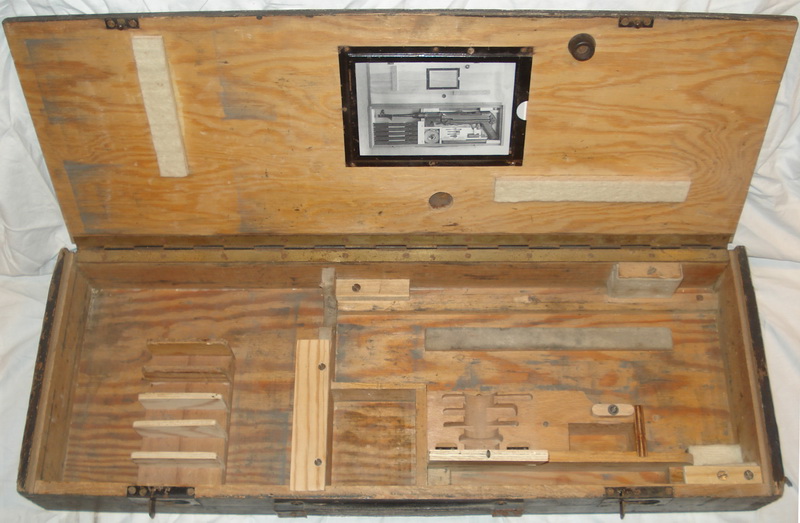 Cleaned up and with replaced parts and hardware (donated from other German WW2 boxes) 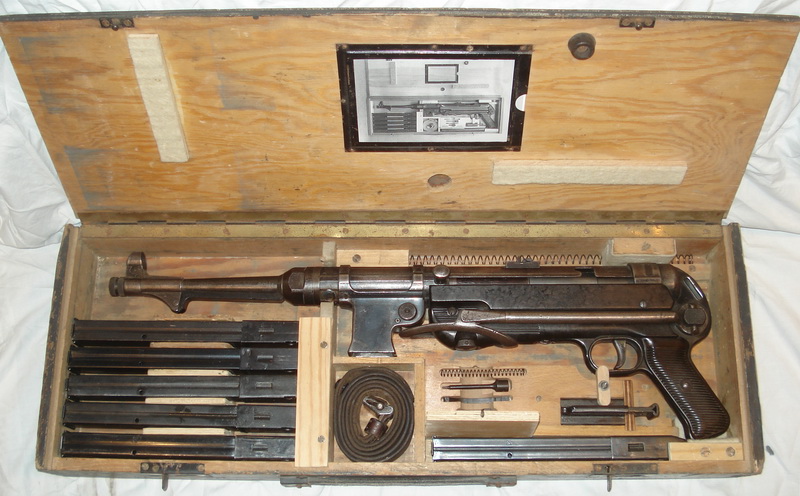 All filled up and ready for service again. |
| Home | For sale | Site map | Contact information | Guest book |